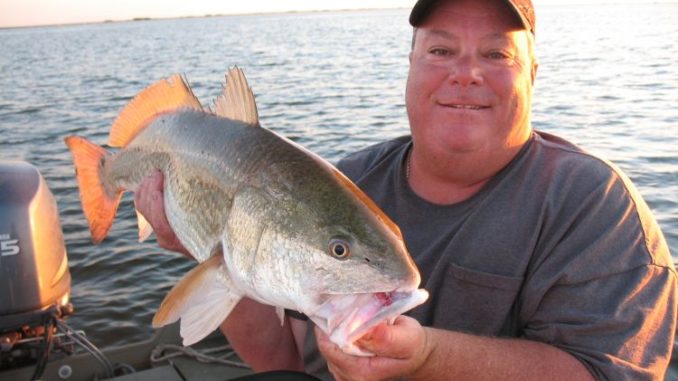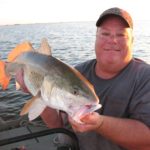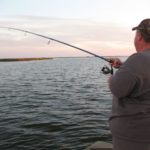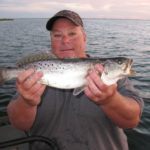
If you’re looking for consistent action for speckled trout and redfish, just head to the little town of Pointe a la Hache. And this guide tells you how to fill the box.
So another December arrives — a month of endings, to be sure, but also of beginnings.
Autumn ends, but winter begins. It’s the beginning of another madhouse Christmas month, but the end of another year.
It’s also a time when folks reminisce and reach out to reconnect with old friends. And reconnecting has never been easier since the advent of cell phones and social media via the internet.
But there’s nothing like reconnecting in person, and revisiting former haunts and friends. Which is exactly what I was thinking of when I called Capt. Chris Danos (504-606-6223) down in Pointe a la Hache.
The last time I fished with him, we put bunches of fish in the boat, and his recent reports indicated there were still plenty of finned friends down there with whom I needed to reconnect at the end of a fishing line.
So we met at Beshel’s Boat Launch before daylight, bought some frisky live shrimp for insurance (just in case the specks were finicky December shoppers) and headed out as daylight peeked over the eastern sky.
We ran east down the Back Levee Canal and took a wide left turn into Lower Grand Bayou. I emphasize the wide turn, because silt from the Mardi Gras breech in the river has filled in the shallow sides of the bayou, leaving only the middle deep enough to traverse.
Evidence of the effects of the unintentional diversion is in what you see and what you don’t see. You see dark, cold, muddy water and plenty of water lilies. What you don’t see is oyster fishermen and their boats at the marina, where they formerly congregated en masse, making their livelihoods dredging for healthy, salty Louisiana oysters.
The muddy river water killed the oyster beds and ended that Pointe a la Hache industry.
It also forces anglers to make longer trips to find speckled trout, but those willing to ride a little farther to do their December shopping will find customers willing to cooperate.
“Normally, this time of year we’d have turned left out of the marina and headed into the main canal into First Bay and Second Bay, Wreck Bay, and up into Oak River and all the usual hotspots in Pointe Fienne, Bay Jack, Skippy and Ponton,” Danos said. “As the water temperatures drop, the trout will move into their deeper water winter spots in Oak River, the Twin Pipelines, and the turns and mouths of the bayous.
“That’s where the action will be as the colder weather settles in, but for now we’re still hammering nice trout in the fringes in American Bay and Grand Point Bay, Bay Gardene and Bay Lafourche.”
Everything depends on the weather.
“Last year, the winter never really arrived down here, and I caught trout all through the season like it was spring,” Danos said. “It has probably been my best season yet as a guide down here, and I won’t complain if winter skips us again this year.”
Not being a fan of cold weather myself, I amened his statement, but I also admit I’m more than ready for some relief from a summer that won’t die.
The 18-foot aluminum boat Danos took out fr this venture proved capable, even handling the small chop in American Bay without complaint.
We soon anchored off a small island and tossed plastics under a cork.
Danos was fishing a glow/chartreuse Vudu shrimp, while I used shrimp creole Matrix on a ¼-ounce chartreuse H&H jighead.
That Matrix or the red ice H&H cocohoe has been a winning combination for me on the last few trips, and it proved itself a winner again on this trip as a hefty speck inhaled it and gave me a surprising fight.
Danos had told me he was catching nice-sized specks, but I chalked it up as “guide-speak.” But he wasn’t joking.
These were 16- to 18-inch specks — way bigger than the 12- to 14-inchers I’d been catching.
The trout were hungry but scattered. We’d have a short burst of action and put several in the boat, and then the action slowed for 10 minutes or so.
Danos tried live bait during the slow times, but it mostly attracted needle fish.
Then his cork disappeared and his rod bent, and the drag sang and we said in unison, “Big red.”
As you know, there’s both good and bad in catching big reds. The good is they’re a blast to catch, to enjoy the fight of a strong fish, to test your mettle as an angler, and to net, photograph and release the brutes to fight again.
The downside is that all the ruckus puts the kibosh on any speck action.
Danos fought the big fish until I netted it.
That was followed by a couple more big reds — these fish obviously had taken up residence in our trout spot and sent the former tenants packing.
We kept a couple for the grill before moving on to continue our trout pursuit elsewhere.
Danos’ December directions:
Danos said he’ll look for several things this month in his quest for speckled trout.
“First, I’ll look for birds,” he said. “If I find gulls diving at the surface and feeding, I’ll sneak in and fish there. Flying, circling birds are easy to spot from a distance and virtually a sure thing.
“Fish them when you find them this month.”
Water clarity also is a concern.
“Next, I’ll hunt cleaner water,” Danos explained. “The river should be low, so hopefully that won’t be a problem. I’ll look for decent water, and once I find that I’ll look for current moving around points and cuts, and that’s where I’ll park and fish.”
Patience is a key factor to success.
“I give a spot 15 or so minutes to produce, or even longer if it’s a normally productive spot,” Danos explained. “And at those kinds of spots, even when I move I won’t move far. Just a little farther down the bank and I’ll try again.
“If you throw out towards open water you should find specks, and if you toss towards the bank you’ll catch reds.”
Fish also will transition as winter sets in, so the availability of deep water is important.
“I’ll fish ledges this month,” Danos said. “As the water chills, especially later in the month, the fish will hang along those drop-offs. I’ll target areas that I know have deeper water and good ledges, especially if there’s an oyster bottom.
“This would be areas along Oak River or any bayou or canal that gets down to at least 5 or 6 feet deep. Toss your bait under a cork over the ledges, or try tight-lining plastic up the ledge.”
Danos also recommended trying live bait if plastics don’t produce.
“Give the fish options,” he said. “Try a live shrimp on a drop-shot rig. If somebody is home, they’ll answer.”
But don’t go deep if you don’t have to.
“Finally, I’ll fish like we’re doing today — under a cork, in the lakes and bays,” Danos said. “If this December is like last year, you can just drift any of these bodies of water that have 3 to 4 feet of water or more, or anchor up at a prominent point with current moving around it or where you see a sign of bait in the water.
“Stick your Power-Pole or Cajun anchor down when you catch a fish to see if more are in the neighborhood. Resume your drift when the action plays out or re-drift a productive area.”
We boated more fish than I wanted to clean by 9:30 a.m. , so I voted we quit early and the motion passed. But Danos stopped a time or two on the way in just to see if trout were there.
They were, and we added a few more to the till at each stop until we called it a day.
Editor’s note: Capt. Chris Danos of Screaming Reels Guide Service can be reached at 504-606-6223.






